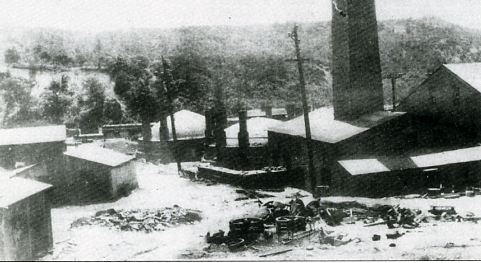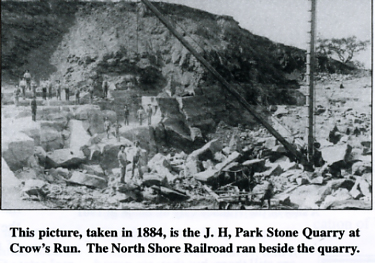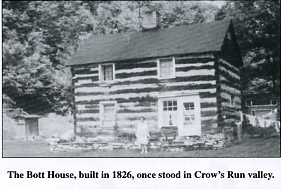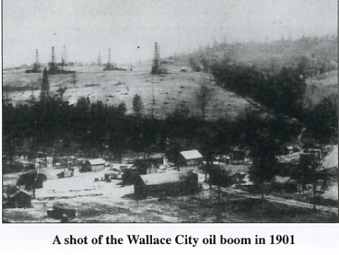
This is the J. H. Park lower brickyard on Crow's Run in 1924.
Click Here to Return to Milestones
New Sewickley Township, situated in the eastern
part of Beaver County, is composed of about 19,279 acres of land
which is of a hilly nature but very fertile.
The southern part of the township is drained by Crow's Run, which
flows southwest through a deep and narrow valley and empties into
the Ohio River at Conway, Pennsylvania.
Crow's Run Valley contains coal, clay, oil, limestone, and vast
amounts of Mahoning sandstone, which is very good for building
purposes. The land in the Crow's Run area was known as Indian
lands until March 12, 1783, when it was set aside as part of the
depreciation lands awarded to those men who served in the Revolutionary
War. This land, until 1789, was priced as low as fifty cents an
acre.
In 1740 John McKee was born and later in his life was exiled from
Ireland in 1765 due to the unrest and turmoil in his native land
and his disagreement with the Imperialistic authorities. To save
his life he chose America to be his future home. Coming to New
England, he found there the same turmoil that he had left behind
in Ireland. Being a hater of tyranny from the very foundation
of his nature, he joined himself in sympathy with the colonists,
and was one of the "Indians" assisting in the destruction
of the tax-ridden tea in the Boston Tea Party. He served two years
in the Revolutionary War and was present at the signing of the
Declaration of Independence. For his services in the war, he was
awarded 800 acres of land in New Sewickley Township beginning
with the Ohio River and extending back over the hills for a distance
of two miles, thus including the Crow's Run Valley. John McKee
kept a store of goods, traded with the Indians and was on friendly
terms with them. In 1825, McKee sold 238 acres to Michael Conway,
which included much of the Crow's Run Valley. The funds from this
and sale of other lands were later used to help finance the construction
of the railroad from Pittsburgh to Beaver County. John McKee died
December 14. 1834 at the age of 94 and was buried in the family
plot at the homestead, located at the top of the hill overlooking
Crow's Run. His headstone reads:
In memory of John McKee who departed this life December 14, 1834,
aged 94, emigrated to this adopted country in the year A.D. 1765,
was at the destroying of the tea in Boston, present at the Declaration
of Independence, served two years in the Revolutionary War and
took his share in the glorious struggle of gaining our Independence.
In smaller letters beneath the inscription is found, "J.
W. Thompson, stonecutter."
The above can be found on page 475, Bausman's History of Beaver
County, 1904.
J. W. Thompson was a son of Joseph Thompson, who was also a Revolutionary
War soldier. His severance pay was ten pounds and ten shillings.
He came to "Old Brighton,' which now is Beaver Falls, in
1795. He later settled on 200 acres in what is now North Sewickley
Township. There he opened a grist mill, a distillery and was a
skilled stonecutter.
I am a direct descendent and six generation of Joseph Thompson's;
therefore I am interested in this bit of biography. Because of
neglect and vandalism to the McKee burial plot, interested citizens
and the American Legion in 1942 had the tombstone removed and
placed in the Oak Grove Cemetery near the Soldier's Monument.
Thomas McKee, born in 1782 in eastern Pennsylvania, the son and
only child of John McKee, inherited the land from his father and
lived on the paternal homestead all of his life, prospered, and
became quite well-to-do. He built a grist mill on Snake Run about
one mile above the confluence with Crow's Run.
This Crow's Run Valley, beginning in 1880 and for the next four
decades became a busy industrial region for the production of
clay, coal, oil, building stone, brick making, and building of
railroads. The creation of these enterprises was due to the foresight
and endeavors of the Park Brothers of Crow's Run, who gave their
share to the development of Beaver County.
William Park, born in Cookstown, County Tyrone, Ireland, emigrated
to Philadelphia in May 1791, learned to be a stone mason and located
in Wilkinsburg, Allegheny County, in 1796, where he instituted
the first Masonic Lodge in that region. He was a member of 479
F. & A. M. at Tullaghage, County Tyrone, Ireland. He died
at the age of 88; his wife Mary McGahey died at the age of 94.
They had the following children: John, James, David, Jane, William,
Robert, and Thomas. David Park, son of William Park, became a
wagon maker, married, and settled in Wilkinsburg about 1844, then
moved to Beaver County and purchased a farm in New Sewickley Township
about one mile from Freedom. He married Ann Hamilton and had the
following children: James, George, William, John, David, Theodore,
Elizabeth, and Mary.

James I Park, son of David Park, learned to be a wagon maker from
his father, then engaged in the lumber business in Freedom for
thirty years. He married Emily McDonald and had the following
children: William A, John H., George I, and Ann.
The members of the Park family who were to establish their various
enterprises in Crow's Run were James I Park (the father) and his
sons William A., John H., and George J. Park. John H. assisted
his father in the lumber business and later entered into business
on his own account. He opened a general store in 1880 at Park
Quarries under the name of J. H. Park & Company. He also opened
a stone quarry there and in 1882 established another quarry at
New Galilee, Pennsylvania. From these quarries he shipped fine
building stone to Pittsburgh, Philadelphia, and surrounding areas.
Some notable buildings erected from this stone were the Pittsburgh
Post Office; Pennsylvania Station at Pittsburgh, Pa.; the First
Presbyterian Church in 1890, Beaver, Pa.; Carnegie Library in
1902, in Beaver Falls, Pa.; and much of the stone used in and
about the Court House in Beaver, Pa.

A post office was established as the Park Quarries
where John H. Park was postmaster and a general store. In 1885
the Park Fire Clay Company was organized at Park Quarries with
G I. Park president, W.A. Park treasurer, and John H. Park as
superintendent. There were two brickyards, known as #1 and #2
works, situated on the west side of Crow's Run. The capacity of
the works was 250,000 bricks daily. There was a paving brick,
burned hard and sized 4x4x9 inches and weighing 9 pounds. The
employees numbered 350 men. These bricks were shipped to all points
in the United States and Canada.
In 1884 John H. Park built a railroad from Park Quarries to connect
with the Pennsylvania Railroad at Conway, Pa., a distance over
three miles, to serve their industries. It was called the North
Shore Railroad. It later was sold to the Ohio River Junction Railroad
Company of which William A. Park was treasurer.
The clay mines were opened to supply the clay for the brickyards
and clay also was shipped as one of their products. A scarceness
of labor became a problem, and they built over twenty-five houses
and an African American church for their employees.

On June 19, 1902, the peace and tranquillity of the village was
disturbed by a murder, the second ever to occur in Beaver County,
by two of the African American employees in a dispute over a woman
of dissolute character. William M. Payne shot and killed Allen
Austin in June of 1902. Payne was tried, convicted, and hanged
on June 9, 1904, in the jail yard at Beaver by Sheriff Howard
Bliss.
At a place called Wallace City, situated at the crossroads of
now Route 989 and the Freedom-Freeport Road near the headwaters
of Crow's Run, an oil boom started in 1900. The first well drilled
on the Robert Wallace farm produced 1400 barrels per day; and
before it was brought under control, thousands of gallons flowed
down Crow's Run to the Ohio River. The well with the largest production,
2600 barrels per day, was drilled on the Whipple farm. Thirty
wells were drilled on the Stewart farm, seventeen on the Whipple
farm, twenty-two on the Kramer farm, and seventeen on the Wallace
farm. Others were Morgan, McElhaney, Stewart, Buck, and Landis
farms. Three pipelines were laid and 500 barrel storage tanks
were built to market the oil. Natural gas was found on several
farms; the one on the Kline farm was till producing in 1950. Wallace
City took its name from the first well drilled on the Robert Wallace
farm; and although it was made up of the usual service buildings
such as boarding houses, blacksmith shops, livery stables, and
other temporary buildings associated with the industry, no permanent
residences were ever erected. It never even became a village or
a hamlet.
The oil boom was of brief duration; and when dry holes began to
be drilled, the business began to collapse, and by 1910 the derricks
and buildings were being torn down and began to disappear. Today
in 1970 there is nothing visible to remind us of oil wells; at
Wallace City, Mother Nature has reclaimed the land. The crossroads
are still there, but they are paved now instead of axle deep in
mud.

During the oil boom at Wallace City, the Park brothers realized
the need for transportation. They extended their North Shore Railroad
on up Crow's Run over three miles from their stone quarries to
Wallace City. In order to do so, they had to blast two tunnels
through solid rock, one about one-fourth mile long. Their plans
were to extend the railroad on to Callery Junction, Pa., and connect
with the Pittsburgh and Western Railroad at that point. After
the collapse of the oil boom, they decided not to extend the railroad
any further. The upper No. 2 brickyard closed in 1919. On June
28, 1924, a hurricane which struck the area of Beaver County causing
tremendous damage to property, caused a flood of Crow's Run that
washed out sections of the railroad tracks, storage buildings,
and caused large piles of bricks stored for shipment to topple
into the stream. It was a severe loss to the owners.
In 1929 the cement industry began to dominate the paving industry;
and together with the depression at that time, the No. 1 and last
brickyard closed its operations. The brick kilns and buildings
were sold as salvage. The Borough of Freedom purchased a number
of them and paved many of the streets with the bricks. The balance
of them were sold to a real estate firm in Ambridge, Pa.
The last business venture of the Park brothers was the attempt
to construct an interurban trolley line between the Beaver Valley
and Butler, Pa.
In 1905-'06 rails were laid in Freedom on 4th Avenue between 2nd
and 7th street, also in Rochester, entering on Case Street via
Pinney Street, Connecticut Avenue, Jefferson Street, and leaving
town via New York Avenue and northbound ending at the borough
line. It also required a bridge in Freedom between Seventh Street
and Ninth Street across Eighth Street and Dutchman's Run. Due
to rival competition and difficulty in obtaining right of way,
this business venture was abandoned with tremendous loss. It was
the last business venture of John H. Park.
William H. Park, born June 13, 1882, died June 20, 1968. He was
married on June 12, 1916, to Lena Evelyn Keiber, a registered
nurse, born in Lincoln, Nebraska, August 1, 1891. They had one
son, William H., born 1919, died 1939. Today Mrs. William H. Park,
Evelyn to her friends, lives in the residence adjacent to where
the Park Quarry Store and post office once stood. She has with
her keen memory and gracious manner supplied much of the information
and valuable pictures which go to make up this history. To her
I am most grateful.
Other accounts of this history are to be found interspersed in
the various histories of Beaver County listed: Caldwell's Atlas
1876, Warner's History of Beaver County 1888, Book of Biographies
1899, Bausman's 1904, Genealogical and Personal History of Beaver
County 1914
All these events took place in the Crow's Run area. Today to traverse
the same region one would find nothing visible to remind us of
a once very busy industrial community. Nature has reclaimed it.
It has been the purpose of the writer to place
the various events in their proper sequence to enable the reader
to follow the course of events as they occurred.
By Joseph Harold Thompson November 1, 1970